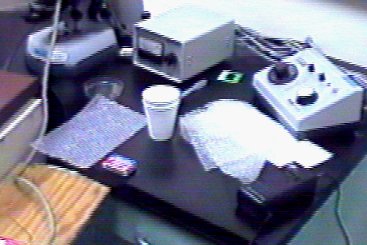 The air might be very dry, in which case the cloud
evaporates quickly. The solution is to place one or two styrofoam cups of warm
water in the bottom of the freezer and change them about every half hour. They
will supply extra moisture to the air.
The air might be very dry, in which case the cloud
evaporates quickly. The solution is to place one or two styrofoam cups of warm
water in the bottom of the freezer and change them about every half hour. They
will supply extra moisture to the air.
There might be some technical difficulties.
Even with all of the lights off, there may be too much light coming from windows. Cover them somehow or request another, darkenable room. However, keep some background light if possible so that people can move safely to and from the freezer.
 The air might be very dry, in which case the cloud
evaporates quickly. The solution is to place one or two styrofoam cups of warm
water in the bottom of the freezer and change them about every half hour. They
will supply extra moisture to the air.
The air might be very dry, in which case the cloud
evaporates quickly. The solution is to place one or two styrofoam cups of warm
water in the bottom of the freezer and change them about every half hour. They
will supply extra moisture to the air.
In one situation an air vent above the freezer dropped dry air into the freezer and the cloud kept evaporating rapidly. I could not move the freezer away from the vent, so I covered it up with my extra sheets of bubble wrap.
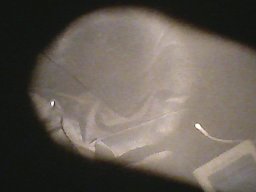 The cloud might be dull white and hard to see. The
problem is that the air is too clean. Our noses and lungs clean the air of
particles on which the cloud droplets might form. The solution is to make the
air polluted.
The cloud might be dull white and hard to see. The
problem is that the air is too clean. Our noses and lungs clean the air of
particles on which the cloud droplets might form. The solution is to make the
air polluted.
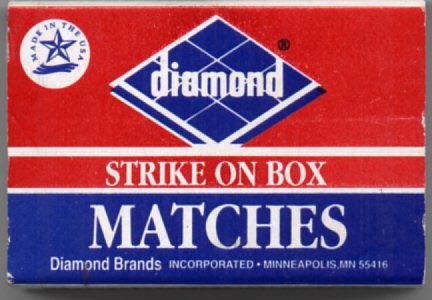 We can do this by burning a match. The flame generates
carbon particles in the air of this room. When I breathe in some of this dirty
air and then blow it into the freezer the result is a much whiter cloud. This
process does not affect the snowstorm process. It may have to be repeated a
few times during the day.
We can do this by burning a match. The flame generates
carbon particles in the air of this room. When I breathe in some of this dirty
air and then blow it into the freezer the result is a much whiter cloud. This
process does not affect the snowstorm process. It may have to be repeated a
few times during the day.
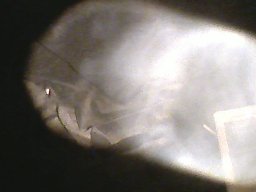 Some of the thicker cloud is entering the view.
Some of the thicker cloud is entering the view.
 The cloud is much more visible now. There is a greater
concentration of particles on which the droplets form, resulting in a denser
cloud of smaller, more reflective droplets, saturating this image.
The cloud is much more visible now. There is a greater
concentration of particles on which the droplets form, resulting in a denser
cloud of smaller, more reflective droplets, saturating this image.
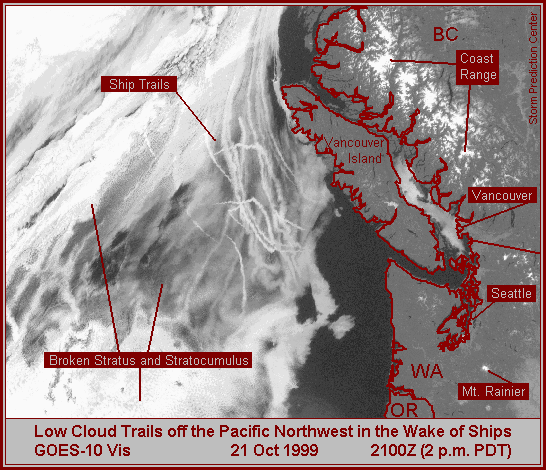


[Daytime visible-light satellite photos
of ocean areas show a similar phenomenon. The exhaust of ships whitens the low
clouds, producing bright lines in the cloud deck, showing their path across
the ocean.]
Sometimes an old freezer warms up too much. The room itself may be warm, particularly after several classes of many warm bodies in a room with poor ventilation. The repeated blowing in of warm moist air from our lungs also warms the freezer. I have found that after about two hours of these 20-minute demonstrations (6 storms per hour) in an old freezer, it was best to let the freezer recover for at least a half hour. [Modern freezers tend to be more efficient and such warming problems may not be a problem.]
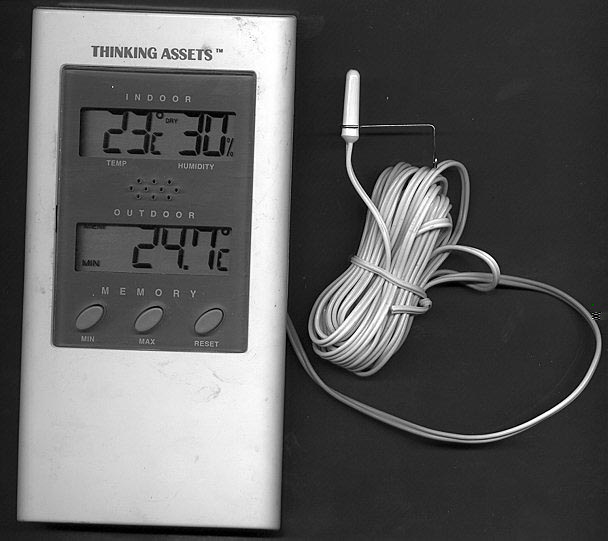 I now monitor the freezer for temperature with this
digital thermometer with large numbers. When the temperature warms to about -6C
I can expect to start having difficulties getting the snow to start. I keep the
freezer on maximum cooling and can usually expect to start at about -20C for
the first classes of the day if I have not transported the freezer very far.
If I have to drive with the freezer for an hour or two, then I need at least
an hour of cooling to become functional before the first class.
I now monitor the freezer for temperature with this
digital thermometer with large numbers. When the temperature warms to about -6C
I can expect to start having difficulties getting the snow to start. I keep the
freezer on maximum cooling and can usually expect to start at about -20C for
the first classes of the day if I have not transported the freezer very far.
If I have to drive with the freezer for an hour or two, then I need at least
an hour of cooling to become functional before the first class.
(Hit your own Back button, else:) Home, equipment, clouds, vapor growth, snowstorm, crystal growth, cloud seeding history, related topics water optics, ice optics